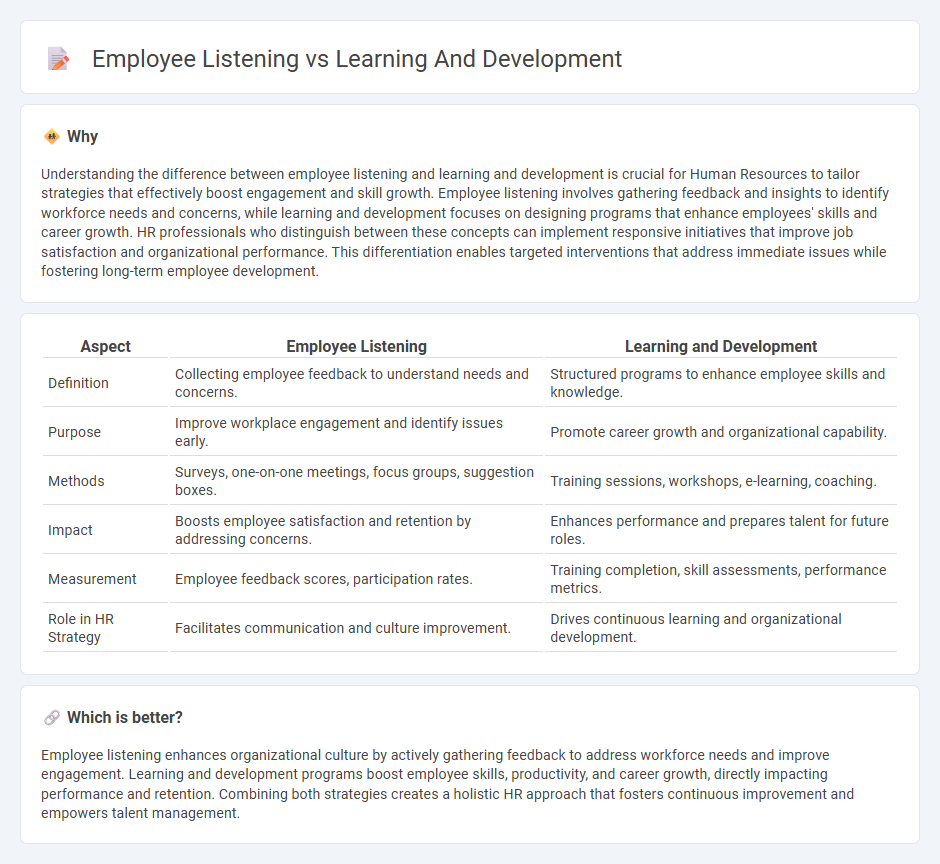
Employee listening gathers real-time feedback to identify workforce needs and improve engagement, while learning and development focuses on structured training programs to enhance skills and career growth. Integrating employee listening with learning and development ensures tailored solutions that boost performance and retention. Explore how aligning these strategies can transform your human resources approach.
Why it is important
Understanding the difference between employee listening and learning and development is crucial for Human Resources to tailor strategies that effectively boost engagement and skill growth. Employee listening involves gathering feedback and insights to identify workforce needs and concerns, while learning and development focuses on designing programs that enhance employees' skills and career growth. HR professionals who distinguish between these concepts can implement responsive initiatives that improve job satisfaction and organizational performance. This differentiation enables targeted interventions that address immediate issues while fostering long-term employee development.
Comparison Table
| Aspect | Employee Listening | Learning and Development |
|---|---|---|
| Definition | Collecting employee feedback to understand needs and concerns. | Structured programs to enhance employee skills and knowledge. |
| Purpose | Improve workplace engagement and identify issues early. | Promote career growth and organizational capability. |
| Methods | Surveys, one-on-one meetings, focus groups, suggestion boxes. | Training sessions, workshops, e-learning, coaching. |
| Impact | Boosts employee satisfaction and retention by addressing concerns. | Enhances performance and prepares talent for future roles. |
| Measurement | Employee feedback scores, participation rates. | Training completion, skill assessments, performance metrics. |
| Role in HR Strategy | Facilitates communication and culture improvement. | Drives continuous learning and organizational development. |
Which is better?
Employee listening enhances organizational culture by actively gathering feedback to address workforce needs and improve engagement. Learning and development programs boost employee skills, productivity, and career growth, directly impacting performance and retention. Combining both strategies creates a holistic HR approach that fosters continuous improvement and empowers talent management.
Connection
Employee listening mechanisms gather insights into workforce needs and challenges, enabling tailored learning and development programs that enhance skill acquisition and job satisfaction. Integrating feedback loops from employee listening systems ensures continuous improvement in training content and delivery methods, fostering a culture of growth and engagement. Organizations leveraging data from employee surveys and performance metrics optimize talent development strategies, boosting productivity and retention rates.
Key Terms
**Learning and Development:**
Learning and Development (L&D) encompasses structured training programs and skill enhancement initiatives aimed at improving employee performance and organizational effectiveness. It integrates continuous education, professional growth opportunities, and competency assessments to align workforce capabilities with business goals. Explore more about how L&D strategies drive talent retention and productivity.
Training
Learning and development (L&D) centers on structured training programs aimed at enhancing employee skills, performance, and career growth within organizations. Employee listening involves gathering feedback through surveys, focus groups, and real-time communication tools to identify training needs and improve engagement. Explore how integrating employee listening insights can optimize L&D strategies for targeted and effective training outcomes.
Upskilling
Learning and development programs prioritize upskilling by enhancing employees' skills and competencies through targeted training and continuous education. Employee listening complements this by gathering feedback to identify skill gaps and tailor development initiatives effectively. Explore how integrating employee listening with upskilling strategies drives workforce growth and engagement.
Source and External Links
Learning and Development: A Comprehensive Guide - AIHR - A systematic process to enhance employees' skills, knowledge, and competency for improved work performance, integrating both learning (acquisition of skills and knowledge) and development (long-term professional growth through mentorship, coaching, and leadership training).
L&D: What Is Learning and Development? - Coursera - An organizational strategy designed to help employees improve their skills and grow professionally, encompassing onboarding, ongoing training, mentorship, and formal classes to reduce turnover and strengthen company culture.
Learning and Development Importance [Updated 2025] - Kaltura - Aligns employee goals with organizational objectives by identifying skill gaps and delivering targeted training, often managed by L&D professionals who create strategies, oversee programs, and integrate technology to support workforce development.
 dowidth.com
dowidth.com